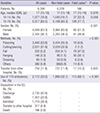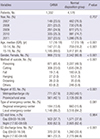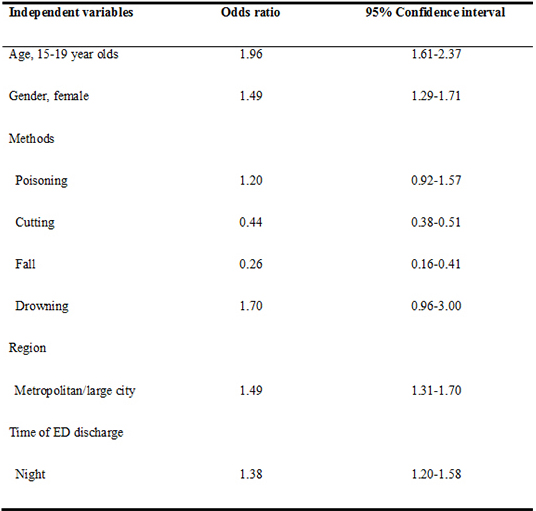1. Statistics Korea. Annual report on the cause of death statistics. Daejeon: Statistics Korea;2013.
2. Jeon HJ, Bae J, Woo JM. Recent statistics and risk factors of suicide in children and adolescents. J Korean Med Assoc. 2013; 56:93–99.
3. Lee CA, Choi SC, Jung KY, Cho SH, Lim KY, Pai KS, Cho JP. Characteristics of patients who visit the emergency department with self-inflicted injury. J Korean Med Sci. 2012; 27:307–312.
4. World Health Organization. WHO suicide prevention. Geneva: World Health Organization;2011.
5. Hawton K, Saunders KE, O'Connor RC. Self-harm and suicide in adolescents. Lancet. 2012; 379:2373–2382.
6. Baptist AP, Warrier I, Arora R, Ager J, Massanari RM. Hospitalized patients with asthma who leave against medical advice: characteristics, reasons, and outcomes. J Allergy Clin Immunol. 2007; 119:924–929.
7. Fiscella K, Meldrum S, Barnett S. Hospital discharge against advice after myocardial infarction: deaths and readmissions. Am J Med. 2007; 120:1047–1053.
8. Hwang SW, Li J, Gupta R, Chien V, Martin RE. What happens to patients who leave hospital against medical advice? CMAJ. 2003; 168:417–420.
9. Anis AH, Sun H, Guh DP, Palepu A, Schechter MT, O'Shaughnessy MV. Leaving hospital against medical advice among HIV-positive patients. CMAJ. 2002; 167:633–637.
10. Aliyu ZY. Discharge against medical advice: sociodemographic, clinical and financial perspectives. Int J Clin Pract. 2002; 56:325–327.
13. Shirani F, Jalili M, Asl-E-Soleimani H. Discharge against medical advice from emergency department: results from a tertiary care hospital in Tehran, Iran. Eur J Emerg Med. 2010; 17:318–321.
14. Brook M, Hilty DM, Liu W, Hu R, Frye MA. Discharge against medical advice from inpatient psychiatric treatment: a literature review. Psychiatr Serv. 2006; 57:1192–1198.
15. Pages KP, Russo JE, Wingerson DK, Ries RK, Roy-Byrne PP, Cowley DS. Predictors and outcome of discharge against medical advice from the psychiatric units of a general hospital. Psychiatr Serv. 1998; 49:1187–1192.
16. Gerbasi JB, Simon RI. Patients' rights and psychiatrists' duties: discharging patients against medical advice. Harv Rev Psychiatry. 2003; 11:333–343.
17. Madge N, Hewitt A, Hawton K, de Wilde EJ, Corcoran P, Fekete S, van Heeringen K, De Leo D, Ystgaard M. Deliberate self-harm within an international community sample of young people: comparative findings from the Child & Adolescent Self-harm in Europe (CASE) Study. J Child Psychol Psychiatry. 2008; 49:667–677.
18. Hawton K, Rodham K, Evans E, Weatherall R. Deliberate self harm in adolescents: self report survey in schools in England. BMJ. 2002; 325:1207–1211.
19. Jeon HJ. Depression and suicide. J Korean Med Assoc. 2011; 54:370–375.
20. Bae SB, Woo JM. Suicide prevention strategies from medical perspective. J Korean Med Assoc. 2011; 54:386–391.
21. Jeon HJ, Lee JY, Lee YM, Hong JP, Won SH, Cho SJ, Kim JY, Chang SM, Lee HW, Cho MJ. Unplanned versus planned suicide attempters, precipitants, methods, and an association with mental disorders in a Korea-based community sample. J Affect Disord. 2010; 127:274–280.
22. American Academy of Child and Adolescent Psychiatry. Practice parameter for the assessment and treatment of children and adolescents with schizophrenia. American Academy of Child and Adolescent Psychiatry. J Am Acad Child Adolesc Psychiatry. 2001; 40:4s–23s.
23. Centers for Disease Control and Prevention. Suicide prevention: youth suicide. Atlanta: Centers for Disease Control and Prevention;2012.
24. Chen YY, Yip PS, Chan CH, Fu KW, Chang SS, Lee WJ, Gunnell D. The impact of a celebrity's suicide on the introduction and establishment of a new method of suicide in South Korea. Arch Suicide Res. 2014; 18:221–226.
25. Suh S, Chang Y, Kim N. Quantitative exponential modelling of copycat suicides: association with mass media effect in South Korea. Epidemiol Psychiatr Sci. 2015; 24:150–157.
26. Waern M, Sjöström N, Marlow T, Hetta J. Does the Suicide Assessment Scale predict risk of repetition? A prospective study of suicide attempters at a hospital emergency department. Eur Psychiatry. 2010; 25:421–426.
27. Currier GW, Fisher SG, Caine ED. Mobile crisis team intervention to enhance linkage of discharged suicidal emergency department patients to outpatient psychiatric services: a randomized controlled trial. Acad Emerg Med. 2010; 17:36–43.
28. King CA, O'Mara RM, Hayward CN, Cunningham RM. Adolescent suicide risk screening in the emergency department. Acad Emerg Med. 2009; 16:1234–1241.
29. Chen CY, Yeh HH, Huang N, Lin YC. Socioeconomic and clinical characteristics associated with repeat suicide attempts among young people. J Adolesc Health. 2014; 54:550–557.







 PDF
PDF ePub
ePub Citation
Citation Print
Print





 XML Download
XML Download